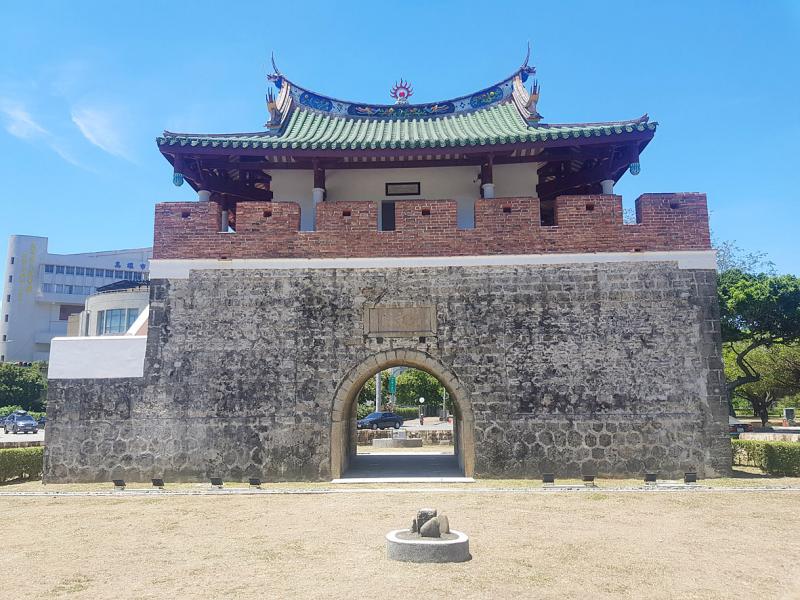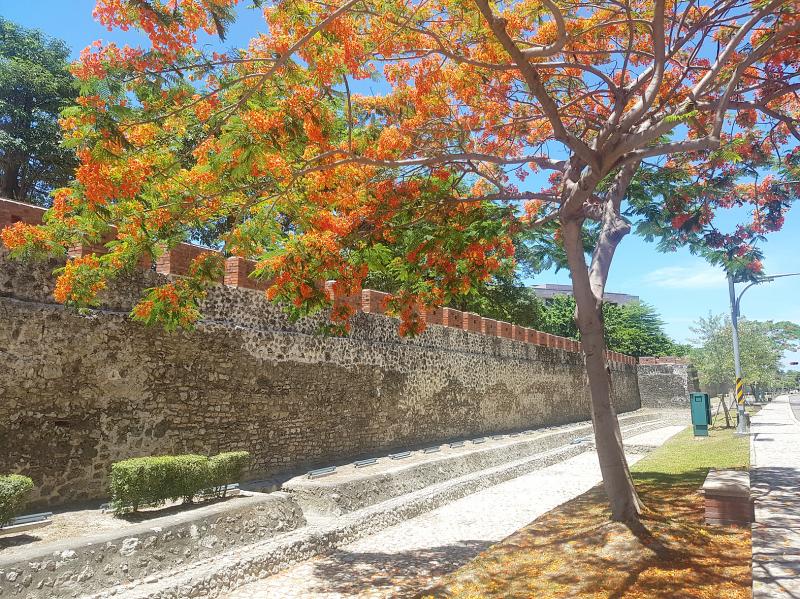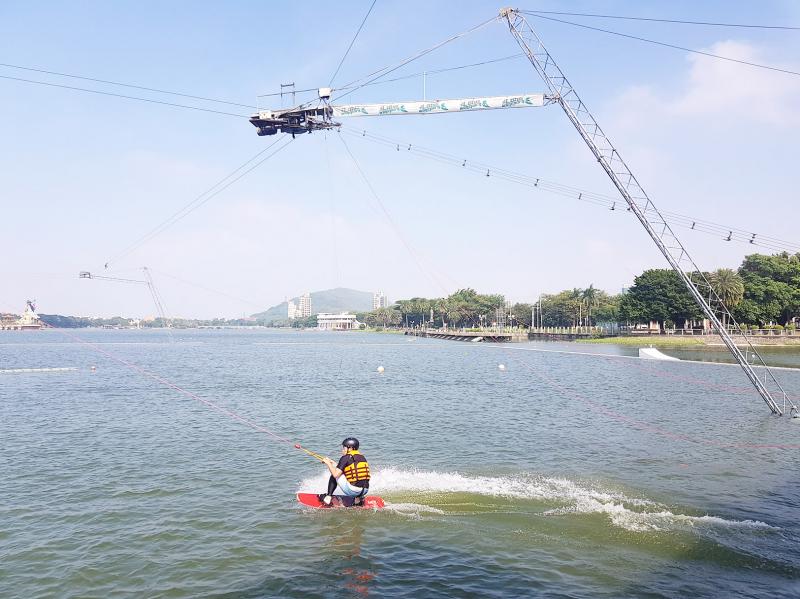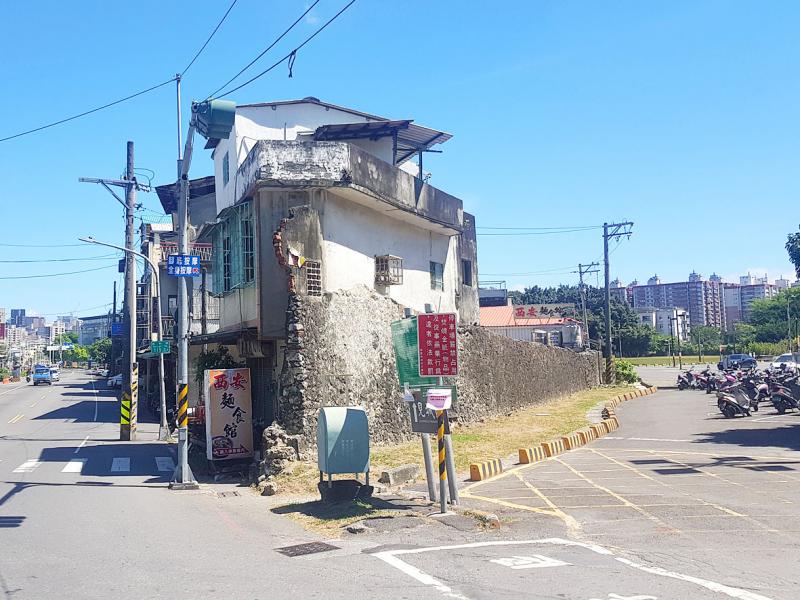After a rebellion decimated the Fongshan County (鳳山縣) capital in 1721, the Kangxi Emperor finally decided to allow the construction of walled cities in Taiwan. The following year, with the completion of an earthen wall surrounding it, Old Fongshan City (鳳山舊城) became Taiwan’s first walled city. Over a century later, the wall was replaced with a stone one, much of which remains standing today. To walk the length of this wall is to walk through centuries of history in just one afternoon, as modern-day amenities intermingle with traces of Taiwan’s past.
Any visit here should begin at the Center of Old Fongshan City History (見城館). It is a modern facility featuring a VR introduction to the area (included in the ticket price of NT$49 for adults, NT$29 for Kaohsiung residents), handheld AR devices to further enrich exhibits and a scale model of the old city. What really makes a visit to the center worthwhile is the multimedia presentation incorporating this model that is played twice an hour. As the history of the region is presented in video format (with English subtitles) on a large screen, different components of the model appear and disappear from the model floor, accompanied by lighting and visual effects, allowing visitors to see 300 years of history played out in front of their eyes. Incredible care went into the preparation of this show and it alone is worth the price of admission.
With a mental picture of the area in mind, it’s time to continue the tour of Old Fongshan City, following the wall counterclockwise. Beside the parking lot, the wall ends abruptly at Shengli Road. During the Japanese era, traffic flow became a more important consideration than historical preservation and it was decided to punch a hole right through the wall and the adjacent Turtle Mountain (龜山) here to allow for quicker access to the Zuoying Station (左營) via Shengli Road.

Photo: Tyler Cottenie
On the other side of Shengli Road, the wall picks up again and rounds the tip of Turtle Mountain where it meets the shore of Lotus Lake. This lake is a tourist destination in and of itself, with an eclectic mix of Daoist, Buddhist and Confucian temples, pagodas, walkways, restaurants and even a water park. A walk around the lake to take in all the sights could easily fill half a day, and the water park features a mix of amenities for all ages, including large inflatable waterslides and a cable-tow wakeboard course.
After rounding Turtle Mountain and crossing Shengli Road once again, the original stone wall continues on toward the North Gate, the only one featuring door guards carved in stone. Across from the gate is the Zhenfu Temple (鎮福廟), whose origins date back to Ming Dynasty times but whose current structure was rebuilt after American bombardment destroyed it in World War II. Look carefully at the middle of this intersection and you will notice a large metal disk. Under this disk is a well, used for centuries by locals for drinking water, but eventually covered up to allow for better traffic flow.
On the inside of the wall near North Gate is Donglai New Village (東萊新村), an unusual collection of houses abutting the wall, sprawled out among a confusing network of meandering narrow lanes that are at times only wide enough for foot traffic. The majority of homes here are one-story structures, only a few ping in size, and in varying states of dilapidation. Some are already condemned for demolition, while others nearby have fresh coats of white paint and could be described as quaint. On the surface, this village appears to be a military dependents’ village, and indeed the original inhabitants did migrate here in 1949 from China. Walking through the narrow alleyways, one can still hear heavily accented Mandarin from elderly residents through open windows and doorways. However, as the original migrants were not actually members of the military, they did not enjoy the same privileges as those in dependents’ villages. The land they occupy is still owned by the military and residents are not allowed to rebuild or enlarge their homes. Residents here face an uncertain future in which they may be forced to leave at any time to make way for urban renewal projects. For now, Donglai Village remains; for how much longer it does so is anyone’s guess.

Photo: Tyler Cottenie
At Zuoying Avenue (左營大路), the original wall once again disappears. The section from here to the original West Gate and further around to the South Gate is almost entirely gone, demolished by the Japanese government to make room for military buildings. One small section of wall, complete with the remains of a Shinto shrine on top, is still standing to the west of Zuoying Avenue. The location of the West Gate was also rediscovered and excavated in recent years. These features are being restored in accordance with the Old Fongshan City Restoration Project, and may soon be open to the public. At the moment, however, the area is still a construction site on military land and no admittance is possible. For now, simply head straight down Zuoying Avenue to its end at a traffic circle, in the middle of which stands the South Gate.
This gate has been cut off from the wall on either side, again to allow for better traffic flow, but is nevertheless beautifully preserved. This gate has the distinction of being the only one of the four with a gatehouse on it, which visitors are free to explore. Just a three-minute walk to the southeast is the Guomao Housing Complex (果貿社區), an architectural, culinary and Instagramming hotspot. Built to replace an earlier military dependents’ village, this 13-building complex features a number of decades-old restaurants serving dishes from different regions in China. At the core of the complex is a park surrounded by two photogenic curved buildings that form a nearly complete circle in the sky.
Continuing counterclockwise along the wall from the South Gate, the wall is essentially intact all the way to the East Gate. This gate is where traffic from New Fongshan City (鳳山新城, modern-day Fengshan District) entered the Old City. Currently, one may still pass over the moat bridge and through the gate on foot or by bicycle. With recent restoration work completed, visitors may also ascend to the top of the gate and walk along a long section of the original wall. The calm surroundings and ability to experience most features of the original wall up close here undoubtedly make this the gate most worth visiting.

Photo: Tyler Cottenie
Continuing along the mostly intact wall on the inside, there is nothing but grassy fields now where military dependents’ villages and a Qing Dynasty academy once stood. For those who still have the energy, Turtle Mountain on the left has a number of hiking paths that include Republic of China military tunnels that are great fun to explore. For those who’ve had their fill of exploring, the parking lot where our journey started is just ahead. Our exploration of the old walled city has come full circle.

Photo: Tyler Cottenie

Photo: Tyler Cottenie

Photo: Tyler Cottenie

Taiwan can often feel woefully behind on global trends, from fashion to food, and influences can sometimes feel like the last on the metaphorical bandwagon. In the West, suddenly every burger is being smashed and honey has become “hot” and we’re all drinking orange wine. But it took a good while for a smash burger in Taipei to come across my radar. For the uninitiated, a smash burger is, well, a normal burger patty but smashed flat. Originally, I didn’t understand. Surely the best part of a burger is the thick patty with all the juiciness of the beef, the

The ultimate goal of the Chinese Communist Party (CCP) is the total and overwhelming domination of everything within the sphere of what it considers China and deems as theirs. All decision-making by the CCP must be understood through that lens. Any decision made is to entrench — or ideally expand that power. They are fiercely hostile to anything that weakens or compromises their control of “China.” By design, they will stop at nothing to ensure that there is no distinction between the CCP and the Chinese nation, people, culture, civilization, religion, economy, property, military or government — they are all subsidiary

Nov.10 to Nov.16 As he moved a large stone that had fallen from a truck near his field, 65-year-old Lin Yuan (林淵) felt a sudden urge. He fetched his tools and began to carve. The recently retired farmer had been feeling restless after a lifetime of hard labor in Yuchi Township (魚池), Nantou County. His first piece, Stone Fairy Maiden (石仙姑), completed in 1977, was reportedly a representation of his late wife. This version of how Lin began his late-life art career is recorded in Nantou County historian Teng Hsiang-yang’s (鄧相揚) 2009 biography of him. His expressive work eventually caught the attention

This year’s Miss Universe in Thailand has been marred by ugly drama, with allegations of an insult to a beauty queen’s intellect, a walkout by pageant contestants and a tearful tantrum by the host. More than 120 women from across the world have gathered in Thailand, vying to be crowned Miss Universe in a contest considered one of the “big four” of global beauty pageants. But the runup has been dominated by the off-stage antics of the coiffed contestants and their Thai hosts, escalating into a feminist firestorm drawing the attention of Mexico’s president. On Tuesday, Mexican delegate Fatima Bosch staged a